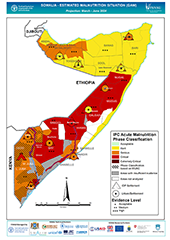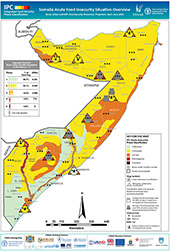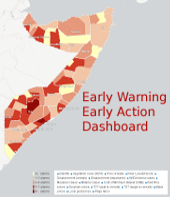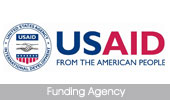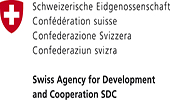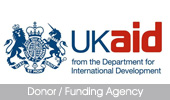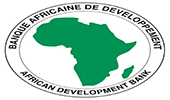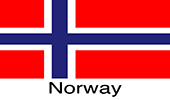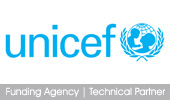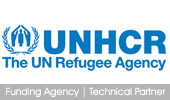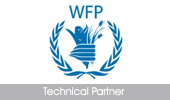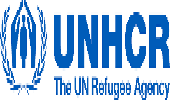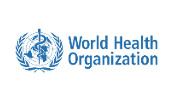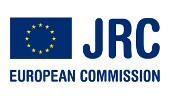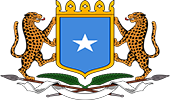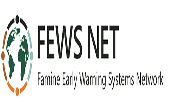Quarterly Brief - Focus on Gu 2019 Season Early Warning
Issued: April 29, 2019
Key Findings
- Below-average rains across most of Somalia during the 2018 Deyr (October-December), followed by harsh weather conditions during the dry Jilaal (January–March 2019) season and the poor performance of the Gu (April-June 2019) rains in April, has led to worsening drought conditions in many parts of the country.
- This has caused deterioration in pasture availability and widespread water shortages in most pastoral and agropastoral livelihood zones, leading to earlier-than-normal water trucking, atypical livestock movements to watering points, and declines in livestock body conditions and milk production.
- The worst-affected areas include Northern Inland Pastoral (NIP), East Golis Pastoral, Addun Pastoral and Hawd Pastoral livelihood zones. In these areas, severe pasture and water deficits and early water trucking have been reported. The harsh Jilaal has also affected rural livelihoods in southern Somalia including Bay/Bakool Agropastoral and Southern Agropastoral of Hiran, although the impact is less severe compared to central and northern regions.
- Limited saleable livestock assets, poor livestock body conditions, reduced access to milk, increased household expenditures on the rising cost of food and water, and overstretched social support networks have led to reduced food access. Further, humanitarian food assistance levels have significantly declined compared to the final quarter of 2018. As a result, food insecurity is worsening among pastoralists in northern and central Somalia.
- Since February 2019, both upstream and downstream water levels of the Shabelle and Juba rivers have remained very low. In some areas, river beds have dried up completely, due to prevailing drier-than-normal weather and high temperatures. This has led to extreme water scarcity for riverine communities. Off-season production in riverine areas was also 11 percent lower than estimates in January 2019.
- The delayed and poor start of the Gu rainfall season has shortened the length of the crop growing season. Given the shortened season, below-average Gu rainfall performance, and very low river levels to date, a significant reduction of 40-50 percent in aggregate seasonal cereal output is expected in July 2019. This scenario assumes the forecast of average to near-average rainfall in May-June in the crop growing areas of northwest and southern Somalia materializes.
- Consequently, food security outcomes in East Golis Pastoral of Bari; Hawd Pastoral of Nugaal, Mudug, Galgaduud and Hiiraan; and Addun Pastoral of Mudug have deteriorated from Stressed (IPC Phase 2) to Crisis (IPC Phase 3), as more households are expected to experience food consumption gaps through June 2019. Most southern regions remain Minimal (IPC Phase 1) or Stressed (IPC Phase 2), due to relatively better 2018 Deyr rains that supported crop production and near-average livestock holdings, though Stressed (IPC Phase 2) outcomes have become more widespread. The exceptions include Bay Bakool Low Potential Agropastoral and Southern Agropastoral of Hiiraan, where significantly below-average Deyr crop production led to Crisis (IPC Phase 3) outcomes. Approximately 1.7 million people are now estimated to be in Crisis (IPC Phase 3) and Emergency (IPC Phase 4) between April and June 2019, an increase of 10 percent from the previous projection of 1.55 million for February-June 2019. The number of people classified as Stressed (IPC Phase 2) remains 3.4 million.
- Food security outcomes are expected to further deteriorate between July and September 2019, driven by the extensive impacts of the poor performance of Gu seasonal rainfall on resource availability and crop and livestock production. In the most likely scenario, East Golis Pastoral of Sanaag, Northern Inland Pastoral, Addun Pastoral, Hawd Pastoral of northeast and central regions, and Southern Agropastoral livelihood of Hiiraan region will deteriorate from Crisis (IPC Phase 3) to Emergency (IPC Phase 4) as food consumption gaps grow, due to significant reductions in food and income sources coupled with progressive erosion of people’s coping capacities. Emergency (IPC Phase 4) will also persist in Guban Pastoral. Meanwhile, East Golis Pastoral of Bari, Coastal Deeh Pastoral and Fishing, Sorghum High-Potential Agropastoral of Bay, Southern Rainfed Agropastoral livelihood zones will deteriorate from Stressed (IPC Phase 2) to Crisis (IPC Phase 3). Most of the rest of the country is classified as Stressed (IPC Phase 2). Accordingly, the overall number of people in Crisis (IPC Phase 3) and Emergency (IPC Phase 4) is expected to increase to approximately 2.2 million through September 2019, with an additional 3.2 million people classified as Stressed (IPC Phase 2).
- In the worst case scenario where the Gu rains continue to perform poorly through the remainder of the season in May and June, further worsening of food security and nutrition outcomes would be likely due to widespread crop failure resulting in deficits of more than 50 percent, a significant increase in livestock losses and significant population displacement. As a result, food security outcomes would likely deteriorate from Crisis (IPC Phase 3) to Emergency (IPC Phase 4) in Sorghum High-Potential Agropastoral of Bay and Bakool and from Stressed (IPC Phase 2) to Crisis (IPC Phase 3) in Southern Agropastoral, Riverine Pump-Irrigation and Riverine Gravity Irrigation livelihood zones, leading to further increases in the number of people in Crisis (IPC Phase 3) and Emergency (IPC Phase 4). Food security and nutrition outcomes among displaced populations are also expected to worsen across the country, with main IDP settlements in Baidoa, Dollow and Mogadishu likely to deteriorate from Crisis (IPC Phase 3) to Emergency (IPC Phase 4).
Click here to download the PDF file of the release.
